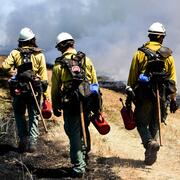Energy Development
Energy Development
Filter Total Items: 24
Developing structured science syntheses for use in NEPA analyses and decision making in the Bureau of Land Management
Science information is fundamental to understanding how proposed actions on public lands may impact the environment. However, agencies often have limited time to compile and synthesize existing science. We are working with land management agencies to develop a new type of science product— structured science syntheses—for facilitating the use of science information in public lands decisions.
Land management research in support of streamlined energy development, economic growth, and wildfire management
FORT researchers provide sound science to support the Department of the Interior in its efforts to streamline reliable energy development, enhance cost efficiency in public lands management, and manage fire-prone habitats for public safety. This research is developed in partnership with resource managers from local, State, Federal and Tribal governments, industry, and nongovernmental organizations...
North American Bat Monitoring Program (NABat)
Bats are essential contributing members of healthy, functioning ecosystems. They perform numerous ecosystem services like insect pest control and plant pollination, and provide enormous economic benefits through ecotourism, medical research, and novel biotechnologies. North American bats face unprecedented threats including habitat loss and fragmentation, white-nose syndrome, and wind energy...
Supporting energy and mineral development through successful reclamation
Federal lands of the US contain important reserves of oil, gas and other resources important for Unleashing American Energy (SO 3418). After development of these resources is complete, successfully reclaiming disturbed lands is a necessary step towards restoring wildlife habitat, forage production, and maintaining natural resources for future use. To improve reclamation outcomes on these lands and...
Developing habitat models for rare plants to inform decision making on multiple-use public lands
Public lands provide important habitat for many rare plants. However, public lands often need to accommodate many other uses, including traditional and renewable energy development, in addition to conservation. We are working with the Bureau of Land Management to coproduce ensemble habitat suitability models that can inform agency planning and permitting decisions that may impact rare plants.
Modeling Songbird Density-Habitat Relationships to Predict Population Responses to Environmental Change Within Pinyon-juniper and Sagebrush Ecosystems
Within areas of overlapping sagebrush and pinyon-juniper ecosystems, wildlife populations are declining due to habitat fragmentation and degradation, changing environments, and human development. However, management to bolster species associated with one ecosystem may result in negative consequences for species associated with the other. Thus, land managers are challenged with balancing which...
New Mexico Landscapes Field Station: Wildlife Research
Below are ongoing or completed research projects related to wildlife at the New Mexico Landscapes Field Station.
Developing searchable annotated bibliographies for resource managers
Resource management decisions need to be informed by up-to-date, quality science and data. However there is sometimes an overwhelming number of scientific publications for managers to consider in their decisions. This project provides concise summaries of recent, peer-reviewed science and data products about different resources and topics of management concern, integrated into a searchable tool.
Greater Sage-Grouse and Mule Deer Population Viability Analysis Across Scales
USGS and Colorado State University scientists will use data about sage-grouse and mule deer population data across Wyoming to evaluate the effectiveness of disturbance thresholds and investigate the efficacy of other disturbance metrics.
Using Long-Term Remote Sensing and an Automated Reference Toolset To Estimate and Predict Post-Development Recovery Potential
USGS scientists are using a time-varying approach to monitor and predict recovery of sagebrush ecosystems following disturbance.
Smart Energy Development: Tools for Informed Development & Successful Reclamation
The USGS is developing science and decision support tools to inform policy and management decisions about various aspects of the energy development life cycle.
Species Conservation
Large-scale changes are occurring to our natural landscapes, often resulting in changes to the distribution and abundance of species living within these landscapes. Populations of many species affected by these natural or anthropogenic changes require focused management to ensure their conservation and sometimes recovery from the brink of extinction.













